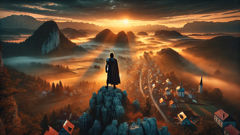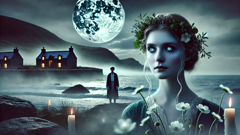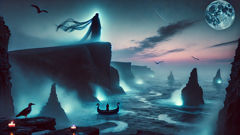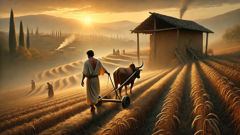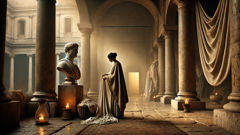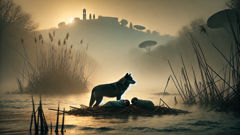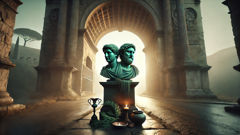Introduction
On the high ridges where limestone drinks the rain and the wind moves like a living thing, there lived a figure whose name many knew and whose memory all felt: Kresnik, the golden-haired protector. People spoke his name in the hush between night and dawn, when village dogs quieted and the scent of woodsmoke still clung to the air. They called him a hero, yet his story is not that of a single battle or a neat triumph; it folds together sunrise rites, animal guides, taboo knowledge, and the uneasy truce between human communities and the spirits that haunt the low valleys and hidden karst caves. In the earliest telling, Kresnik is as much a ritual role as a person: a shamanic presence who could ride the winds in the shape of hawk or horse, move without leaving footprints, and bring back warmth and harvest from the places where shadows gather. His hair shimmered like dawn itself, and people said the light caught there when the first ray of sun broke across the meadows. Yet with that light came an obligation. Whenever the border between day and night thinned—during long winters, during strange omens like a boiling fog that swallowed livestock, during nights when the stars slid out of their places—Kresnik rose, not merely to fight monsters but to restore the balance that holds men and spirits in fragile accord. This story is woven from the bones of those old songs and the breath of the landscape: the plateaus that smell of thyme and rain, the deep forests where oaks remember the names of the dead, the cobblestone lanes of small villages, and the caves that hum with underground rivers. Listen for the rhythm of the village bell, the creak of a cart, the hush of wind through stubble, and you will hear the pulse that called Kresnik forth. In the retelling that follows, I aim to carry you across that ridge and down into the valley, to watch with the villagers as dawn paints his hair and night ships its terrors toward the hamlet, and to feel how courage, ritual, and stubborn human warmth shape a myth that still holds meaning for people who live where the earth remembers its old bargains.
Dawn Over the Karst: The Birth and Calling of Kresnik
They say he was born on a night when the northern winds forgot their names. The midwife's hands were steady, but the household dogs howled for reasons the women could not speak, and the men placed iron along thresholds as if to remind the world where skin ended and stone began. The child came with a crust of light on his brow—so the old ones claimed—and by the time the first rooster crowed the hair at his temples shone like the sun sliding through a glass of honey. From the earliest days, Kresnik was a child of edges: between childhood and adulthood, between the world of the living and the world that shuffled at the boundary of dreams. He understood the language of birds before he understood the names of men; he listened to the river tell him secrets in the pause between breaths. Such gifts drew curiosity and fear in equal measure. Elders traced lines on the palms of villagers and found signs that matched the old ritual charts: the spiral of a snake, the crossing of a staff, the pattern that meant a soul could walk the two roads. Kresnik's mother humored the old rites with a tenderness that had less to do with superstition than with gratitude; she had been told she would bear a child who would bring light back when the shadows grew thick, and she held to that promise like a warmth against winter.

In the years that followed, as Kresnik grew, the hamlet learned the rhythms he kept. When winter's crust pressed down hard and wolves nosed close to the folds, he walked the boundaries at sunrise, his silhouette long and yellow as a reed. When stillness wrapped the valley in a white sheet and the moon sat like a polished coin, he traced the lines around barns and hearths, humming a song older than grain. People brought him linen and bread, small offerings placed under the juniper and yew. In return he taught children how to listen to the weather: the way the smoke drifts tells you rain is coming; the way the cattle shift their weight tells you when a wolf is near. He showed the women how to burn certain herbs so that nightmares would not grip their sleeping sons. In some winters he rode through the air in the shape of a white horse, a trick learned from the spirits themselves; in others he walked like any shepherd, feet leaving prints that melted into the thaw.
Kresnik's power was never mere strength. It was a knowledge of thresholds. He learned the old rites from a woman they called the Potteress of Cerknica, who baked more than clay; she baked talismans into oven corners and wrapped prayers in rye dough. From her he learned to weave cord and chant so that the cord could hold the memory of a name. He apprenticed to a blind elder who read the runes in the curl of a tree root and taught Kresnik to speak to the dead with a voice that did not frighten them. These lessons were practical as well as mystical. The hamlet's survival depended upon them: the choice of seed, the timing of lambing, the way to find clean water beneath the stony plateau. Kresnik's shamanic work—binding, unbinding, guiding the lost to their homes—kept the fragile social weave functioning. When a dispute rose between neighbors about a stolen cow or a field boundary, Kresnik did not raise a sword. He sat the men by the beehive, spoke a truth-song, and let the hum of the bees move the anger into comprehension.
But the world had edges that were not meant to be smoothed. There were nights—long, starless nights—when the thin lines between worlds frayed and dark things pushed like cold fingers through the seams. Those nights birthed the stories that made mothers draw quilts tighter. They told of shadow-serpents uncoiling from sinkholes, of night-maids who stole the breath of young calves, of old chiefs transformed into stone for breaking oaths. Kresnik's calling sharpened on such nights. He did not seek glory; he sought the repair of those torn places. When mist rose from the karst hollows and the dogs howled in a certain cadence that said the air carried wrongness, Kresnik rode the wind. Riding was an image that meant both travel and state: he traveled as men travel by foot and yet also rode as shamans do, slipping into the skins of animals, drawing power from the spirit realm. Each journey cost him something. Sometimes it was the taste of his mother's fresh bread; sometimes it was the hush of one more night when he could not sleep. But each time Kresnik returned with a token to hang on a door: a carved bone, a strand of dyed wool, a small iron nail blackened by ritual smoke. These were not mere trinkets. They were stitches sewn into the world so that it might hold together.
As seasons spun, the tale of Kresnik grew more layered. Merchants who passed through the valley brought new names and new dangers: a plague of locusts one year, a priest from a distant town who spoke of different gods another. Kresnik adapted. He learned to build new bridges between old rites and changing needs. He met other figures who claimed kinship with him across the sloping lands—men and women whose names shifted with dialect but whose function remained the same: guardians of thresholds, keepers of dawn. With other guardians came rivalries, but more often they shared techniques: how to braid yew and willow for protective fences, which stones to stack by a spring so that the water would not forget its way, how to hollow out a drum that could call a storm's mercy. In all these exchanges, Kresnik's golden hair became a symbol more than an oddity. It was the light the people could see and trust in times that crushed faith into brittle things. When mothers hung talismans above cradles, they told their children that Kresnik's hair was the color of the first wheat; when shepherds watched the horizon, they wished for the flash of that hair as a sign the watch would pass without trouble.
This was not, however, a life of untroubled triumph. Power draws attention, and attention draws tests. Kresnik faced trials that were not only made of shadow but also of doubt. There were seasons when the harvest failed in spite of his rites, winters that tested oaths and friends who turned away. In those months rumors gathered like frost: perhaps his power was borrowed and could be called back; perhaps his golden hair was a trick of light. The young sometimes mocked what the old revered. Kresnik bore these things with a quiet that was not surrender but the kind of patience born of hard knowledge. He understood that myth endures not because it is unassailable but because it is useful: a vessel into which human beings pour their fears and hopes and then, together, raise a flame. When the worst nights came and the villagers wondered whether the old ways could keep them, Kresnik rose at the thin edge of dawn and did what he had always done—he walked the line between the living and the hidden, repeating chants like a slow thread, coaxing the world back toward its pattern. In doing so he stitched himself into a people's memory, not as an immortal being beyond reach, but as one who taught others how to stand against the dark.
In the valley, long after his mortal years would have ended, people continued to tell of him as if the telling could keep him whole. Around hearths and at market stalls, through feast days and wakes, the name Kresnik threaded through conversation. Fathers would nudge sons and whisper the old warnings: do not go alone when the mist is low; do not break an oath to the land; do not leave a lantern unlit on nights when the moon hides. And always, alongside warning, there was a call to action: be a neighbor, remember your obligations, honor the thresholds. Those repeated outlines of conduct are how the myth did its work: practical, moral, and necessary. Kresnik remained, therefore, not only a figure to be remembered but a presence that shaped how people lived. His golden hair became less about a single man and more about the light people kept—through rites, through vigilance, through mutual care—that made living possible in a landscape that could be as generous as it was stern.
Night of the Shadow-Serpents: Trials, Alliances, and the Ritual of Return
There are nights that live in memory like scars: specific, aching, and instructive. One winter, when the floods had been late and the wolves unusually bold, a strangling mist slipped out of a fissure in the earth. It rolled down into the valley, white and oily, and brought with it a chorus of sounds that made the villagers clutch their hearths. Pregnant ewes lost the shape of light in their eyes; wells dried up for a day and then returned brackish; the bell at the chapel rang six times though no hand touched it. Older mouths told older stories and the word spread in low, urgent tones: the border had thinned. Kresnik heard those tones like a drum and came out before dawn, hair braided with cedar and small iron amulets. The villagers watched him walk away as if into a dream.

Kresnik's journey that night was not only through landscape but through story. He walked into places the villagers had mapped not with compass and grazing rights but with songs: the limestone swallowhole where the old woman had disappeared, the coppice where children said they saw lights moving like fish, the oxbow of the stream where the water remembered an older name and sometimes refused to answer when called. He moved as a man who knows his way by pressure and scent, by the memory of a stone that is just a little warmer than the others. And at each place he performed work that combined craft, music, and precise small violence. He dug trenches and sang into them; he laid bones into hollows with words that made the bones remember something they had forgotten. He fought in forms that were not purely physical. Against a coil of shadow-serpent that slithered out of a sinkhole, he did not meet teeth with steel; he made a song that sounded like thunder without wind and set out mirrors carved from old horseshoes so the serpent saw itself in the light and recoiled. Against the night-maid who wanted the breath of newborn lambs, he offered a bowl of salted oats and whispered a bargain into the grain husk. These bargains were older than blood pacts: they were the sort of agreement the land accepted—give something of equal value, and the tide will stop.
Not all fights ended elegantly. Kresnik paid for each success. After the night of the shadow-serpents, he returned with a limp that never quite left him and with a silence in one eye when he told the story. He had crossed a boundary that expected payment, and even as he saved a village a part of his human self was rearranged. People called such costs the balance of exchange; they were a reminder that heroes are not saints. Yet the myth accompanying such costs also gave villagers tools to shoulder responsibility. Kresnik taught them to build more than walls; he taught them to hold rituals together so that power would not concentrate in one man. He led a communal festival at the first thaw, when men and women gathered to braid light into cords—cords that, when hung over thresholds, were thought to hold back the particular kind of weather that brought creeping rot. The festival involved dancing, story-swapping, a mock trial of miscreants where children acted out the consequences of breaking oaths, and a final shared meal by which the community sealed its mutual obligations. The ritual was as much social glue as spiritual defense. It made the village stronger not only by beating back spirits but by insisting that care was shared.
Kresnik's alliances extended beyond people. He befriended animals and old spirits with names almost lost to language. A hawk that nested on a cliff taught him to cut wind with a wing's memory. A water-spirit who lived underneath a particular spring told him which stones to set so the flow would not forget its path. In return he mended their hurts: he unwrapped barbed wire from a buck's antlers and set a nest of clay in a hollow for a spring-queen whose eggs had been disturbed by children building dams. These relationships are essential to the myth's purpose: they teach reciprocity with more-than-human beings in a landscape where everyone competes for the same scarce mercy. Kresnik's golden hair is frequently described as catching light because that hair symbolizes the visible sign of those reciprocal bargains; it tells the community where to turn in times of trial.
Enemies come in shapes the mind can imagine and shapes it cannot. One year, a stranger arrived in the valley—a man in a long coat stitched with a language none could read. He spoke of progress and gave gifts of metal that hummed with a different kind of promise. Some villagers were intrigued. Others felt unease. This stranger's metal, when laid at the mouth of a spring, changed the taste of the water in subtle ways. Kresnik watched these changes and when he confronted the stranger he did so not with curses but with a test: could the metal answer a question the spring had always known? The stranger could not, and his promises unraveled. Stories like these remind us that the myth keeps shape by distinguishing necessary innovation from the erasures that leave the soil raw. Kresnik's role was less to halt change than to insist on memory within it.
There were also darker men who exploited both fear and faith. A local chieftain once tried to claim Kresnik's role for his son—declaring him the village's chosen man and closing the community to others who practiced the old ways. Kresnik opposed this, not out of vanity but because ritual power that is hoarded becomes a blade. He staged a public test where the would-be chieftain's son had to listen to the shriek of a house-owl and repeat what it had said. The boy failed; he had only learned to mimic words. Kresnik's intervention prevented the consolidation of power that would have left the valley vulnerable. The myth thus functions as a civics lesson: guarding not just against spirits but against abuses of trust.
Most dangerous of all are the nights when the villagers question whether the stories are real. Skepticism is not only modern; there have always been skeptics. When belief frays, the myths must be acted on in new ways to remain alive. Kresnik understood this. He made room for doubt. He taught that the reason to keep a lantern lit at the edge of the field was not superstition but a practical way to deter wolves; the reason to retell the story of a vanished child was to keep attention alive on the places where children playing might stray. Rituals changed shape, songs lost verses and gained new ones, and all the while the central idea endured: boundaries must be observed, bargains honored, and light must be brought where it is needed. The hero's stories thus operate on two planes: they are dramatic tales of combat with darkness and also survival manuals for living in a land that demands constant attention.
In one final story, told by a woman whose hands trembled with age, Kresnik did not return from a journey. She insisted that on a night when the moon hung low and the fog smelled of seaweed, he climbed the highest ridge and walked into the east. Some say he rode the wind and joined the streams; others say he merged with the first ray and hollowed out a place in it to keep watch. The woman said this with neither clear belief nor simple doubt; she said it as someone who knows the difference between the truth that keeps you up at night and the truth that keeps you going. For the villagers the ending was less important than the practice. Whether Kresnik rose into sun or sank into peat, his light remained because people continued to enact it. They braided wool with herbs, they kept talismans over doorways, and they taught their children where the sinkholes were and why you never whistle into them. The rituals fed the myth, and the myth fed the rituals. That mutual nourishment is what allowed small communities to remain alive in a landscape that could easily forget them.
The tale of Kresnik is not a single spine of events but a braided rope of lessons. Each knot—battle, bargain, failure, communal feast—teaches a way of being. For modern readers, the story suggests a kind of stewardship where humans acknowledge limits and build alliances with the living world and each other. For those who still live beneath the karst ridges, it remains a living memory: practical, moral, and consoling. Kresnik's golden hair, then, is both symbol and tool: it is the visible sign of the work of waking a community to its responsibilities and of holding back the creeping cold of night. His story endures because, ultimately, it is about the ordinary courage of people who choose to be present and to protect the fragile weave of life where they live.
Conclusion
Stories like Kresnik's survive because they do more than narrate a sequence of events; they encode a way of relating to the world that is at once spiritual and practical. The golden-haired hero is both a solitary figure crossing thresholds and a community's reflection of how it must act to endure. Through ritual, alliance with animals and spirits, and the persistent work of making bargains with the landscape, people learned to ward off dangers that have little patience for neglect. Kresnik's myth asks a simple question: what will you offer when the night comes close? The answers people gave—cords braided at dawn, songs repeated at feast, iron nailed into doorframes, stories passed from parent to child—are the true subjects of this tale. They teach that heroism is often less a flash of bravery than the patient repetition of small care, the daily choices that stitch a world together. If you stand at a dawn over a karst ridge today, listen closely; you will hear not only the wind but the echo of chants, the clack of a certain old drum, and perhaps the memory of golden hair catching the first light. That memory is a map: a direction to live with attention, to keep a light, to hold faith with the delicate bargains that keep communities and landscapes whole. Whether Kresnik walked into the sun, melted into mist, or simply kept walking among the people, his story remains because people needed a way to imagine the courage to protect both life and the ties that make it possible.

